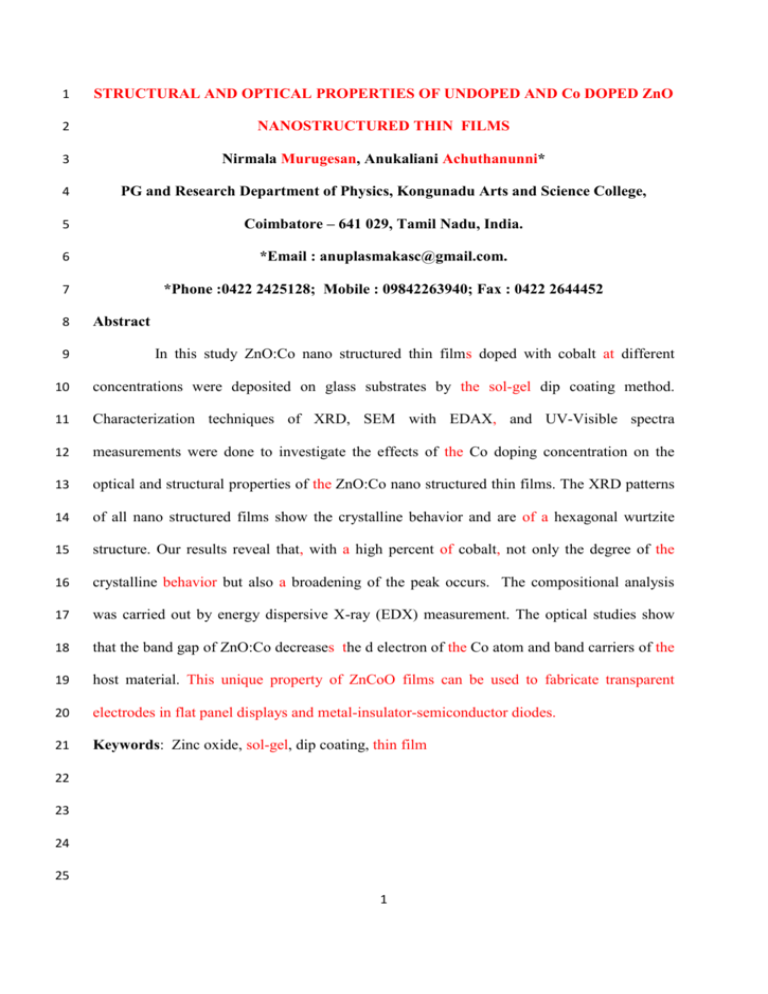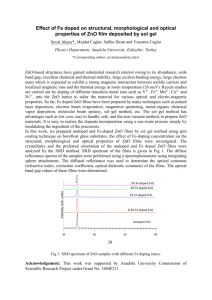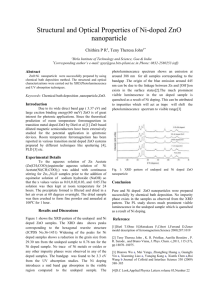1003021
advertisement

1 STRUCTURAL AND OPTICAL PROPERTIES OF UNDOPED AND Co DOPED ZnO 2 NANOSTRUCTURED THIN FILMS 3 Nirmala Murugesan, Anukaliani Achuthanunni* 4 PG and Research Department of Physics, Kongunadu Arts and Science College, 5 Coimbatore – 641 029, Tamil Nadu, India. 6 *Email : anuplasmakasc@gmail.com. 7 *Phone :0422 2425128; Mobile : 09842263940; Fax : 0422 2644452 8 Abstract 9 In this study ZnO:Co nano structured thin films doped with cobalt at different 10 concentrations were deposited on glass substrates by the sol-gel dip coating method. 11 Characterization techniques of XRD, SEM with EDAX, and UV-Visible spectra 12 measurements were done to investigate the effects of the Co doping concentration on the 13 optical and structural properties of the ZnO:Co nano structured thin films. The XRD patterns 14 of all nano structured films show the crystalline behavior and are of a hexagonal wurtzite 15 structure. Our results reveal that, with a high percent of cobalt, not only the degree of the 16 crystalline behavior but also a broadening of the peak occurs. The compositional analysis 17 was carried out by energy dispersive X-ray (EDX) measurement. The optical studies show 18 that the band gap of ZnO:Co decreases the d electron of the Co atom and band carriers of the 19 host material. This unique property of ZnCoO films can be used to fabricate transparent 20 electrodes in flat panel displays and metal-insulator-semiconductor diodes. 21 Keywords: Zinc oxide, sol-gel, dip coating, thin film 22 23 24 25 1 26 Introduction 27 The sol-gel process (Sagar et al., 2005) is simple and inexpensive in 28 fabrication, capable of producing a large number of samples, has easier composition control 29 and an accurately controlled mole ratio, has high solubility, better homogeneity, a lower 30 processing temperature, and has a general advantage for large area deposition and thickness 31 of the films. 32 manganese doped ZnO (Sharma et al., 2003; Shinde et al., 2006), fluorine doped ZnO 33 (Olvera et al., 2002; Guillen-Santiago et al., 2004), and indium doped ZnO (Lucio-Lopez et 34 al., 2006) among others. On the other hand zinc oxide thin solid films have prompted as 35 much interest as transparent conductive oxides due to their valuable properties such as high 36 optical transparency in the visible region, low electrical resistivity, as well as high electro- 37 chemical stability, abundance in nature, and absence of toxicity (Ismail et al., 2001). These include cobalt (Co) doped zinc oxide (ZnO) (Ivill et al., 2008), 38 Co doped ZnO thin solid films have been obtained by chemical and 39 physical techniques, such as ultrasonic spray, sol–gel (Manivannan et al., 2001), and pulsed 40 laser deposition (Fitzgerald et al., 2005). Doped with a 3d transition metal and highly 41 transparent and conducting, ZnO is promising for the emerging field of spintronics because it 42 can readily be deposited as a thin film. The difference in radii between divalent high-spin Co 43 in tetrahedral coordination (0.58A˚) and divalent Zn in tetrahedral coordination (0.60A˚) are 44 small and a Co content of more than 8 % was obtained. Some recent works (Olvera et al., 45 2002; Kim et al., 2002; Moreno et al., 2006; Pan et al., 2008; Song et al., 2007; Schmidt et 46 al., 2007; Bhatti et al., 2008) have reported optical, morphological, and magnetic properties 47 of Co doped ZnO thin solid films using different deposition techniques. In this paper, the 48 structural, morphological, and optical properties of ZnCoO films were characterized in detail. 49 The characterizations revealed an intrinsic nature between the properties and structure in Co 50 doped ZnO films. 2 51 2. Experimental method 52 The precursors utilized for the synthesis of ZnO:Co are: Zinc acetate dehydrate 53 [Zn(CH3 COO)2 2H2 O], cobalt acetate tetrahydrate [Co(CH3 CO)2 4H2 O], 2-mithoxyethanol 54 (DME) [C3 H8 O2], and monoethanolamine (MEA) [C2 H7 NO] as the zinc and cobalt 55 sources, and solvent and stabilizer respectively. All chemical materials were purchased from 56 Merck & Co., Inc., USA, and were applied without more purification. 57 All samples of ZnO:Co nano structured thin films were prepared by the sol-gel 58 method. First, at room temperature, zinc acetate and the dopant were dissolved in a mixture 59 of DME and MEA solution. The molar ratio of MEA to Zn+2 was maintained at 1. Solutions 60 were prepared containing zinc acetate, cobalt acetate 10, 12, and 14 % DME and MEA. At 61 70˚ C, solutions were vigorously stirred for 1 h by means of a magnetic stirrer to yield a clear 62 and homogeneous solution. At room temperature, the coating solutions were aged for at least 63 1 day, and then deposited on glass slide substrates, which were cleaned before by dip coating. 64 The undoped ZnO precursor was prepared in the same way. The glass slide was dipped in sol 65 solution for 5 minutes, and then the film was preheated at 150°C for 15 minutes to evaporate 66 the solvent and organic residuals. This procedure was repeated 5 to 8 times to reach the 67 desired thickness. Finally the film was post-heated at 300°C for 1 hr. 68 In this work, our intent is the investigation of the band gap in ZnO:Co nano films 69 and so we avoided other further characterizations. The desirable characterizations are X-ray 70 diffraction, compositional analysis, and ultraviolet-visible (UV/Vis) spectra measurements 71 for investigating the effects of the doping concentration on the properties of Zno:Co nano 72 structured thin films 73 74 75 3 76 3.Results and Disscussion 77 The x-ray diffractometer (XRD 6000, Shimadzu, Japan) with α CuK line 78 radiation (λ = 1.5406 Å) was used for determining the crystallite phase and orientation. The 79 crystalline size of undoped and Co-doped ZnO is calculated using Scherrer’s formula, 80 D= Kλ β Cos θ 81 Where The constant K is the shape factor = 0.94 82 ‘λ’ the wavelength of X-rays (1.5406 for Cukα) 83 θ is the Bragg’s angle 84 β is the full width at half maximum 85 Figure 1.a, 1.b, 1.c, and 1.d shows the XRD-ray patterns of all samples which were deposited 86 on the glass substrates. The diffraction patterns reveal a good crystalline behavior without 87 any appreciable changes from pure ZnO films and are genuinely polycrystalline with the 88 hexagonal wurtzite structure. These results imply that there are no secondary phases such as a 89 cobalt cluster or oxides. Wide distribution of the grain size of the samples on the film can be 90 a possible reason resulting in the broadening of the diffraction peaks. The result obtained is in 91 good agreement with the work done by Li et. al., (2007). The lattice parameters and the 92 crystalline size of the ZnO and ZnCoO samples are shown in Table 1. 93 Surface morphological studies of undoped and Co doped ZnO films have 94 been carried out using a scanning electron microscope. Figure 2.a, 2.b, 2.c, and 2.d shows the 95 SEM images of the undoped and Co doped ZnO films. SEM images of the ZnO resemble a 96 granular surface. Incorporation of Co ions changed the surface morphology to a wrinkled 97 network. Due to the enhancement of the dopant concentration more impurities were included 98 into the ZnO crystal, resulting in more defects in the crystal so that the crystallinity of the 99 films was affected as seen in the XRD. For the 14% Co concentration the morphology of the 4 100 film changed to a network and this is in good agreement with the literature (Srinivasan and 101 Kumar,2008; Habibi and Sardashti, 2008). 102 For determining composites in different Co doping concentrations of ZnO:Co nano 103 structured thin films, compositional analysis was performed on a Philips XL 20 SEM (Philips 104 Electronics, NV, Netherlands) by energy dispersive X-ray (EDX) analysis. The EDX 105 spectrum of pure and Co doped ZnO nanostructured thin film is shown in Figure 3.a, 3.b, 3.c 106 and 3.d. Table 2 gives the ratio of Zn:Co:O elemental composition. EDX analysis showed 107 that the amount of Co element in the sample increased depending on the increasing Co 108 incorporation in the solution. As a result Co incorporation has a strong effect on the optical, 109 structural, and morphological properties of ZnO. 110 Room temperature optical transmittance was measured by a Varian Cary 100 111 UV/Vis spectrophotometer (Varian, Inc., USA). Figure 4 shows the optical transmittance 112 spectra of the films in the wavelength region range from 500 to 2500 nm. It is evident that the 113 optical transmittance increases in the visible region and decreases in the UV region for a 114 sample. With the increase of 0,10,12, and 14 % Co concentration, the optical transmittance 115 spectra of the samples gradually decreased in the visible region. Transmittance in the 116 undoped film is almost 90-95% for the visible region. The optical band gap of the Co doped 117 ZnO nano films was estimated by extrapolation of the linear relationship 118 (αhν) 2 = hν − Eg , 119 where α is the absorption coefficient, 120 hν is the photon energy, 121 and Eg is the optical band gap of nano films. 122 It is determined by theory of the direct optical absorption. Figure 5 shows the (αhν)2 vs. 123 photon energy curves of ZnO nano films with varying doping concentrations and the band 5 124 gap values are shown in Table 3. The band gap value decreases with the increasing Co 125 doping concentration. This may due to the sp-d exchange interactions (Singh et al., 2009). 126 4. Conclusion 127 Co doped ZnO nano films were prepared with different values of Co content 128 by the sol-gel dip-coating method. The diffraction patterns reveal a good crystalline behavior 129 with the hexagonal wurtzite structure. The EDX of the samples were prepared with different 130 values of the Co/Zn atomic ratio. Room temperature optical transmittance spectra of samples 131 were performed and showed that the visible transmission of films generally decreases with 132 the increase of the Co content and is high (>90%). Due to the exchange interaction between 133 the localized d shell electrons of the magnetic ions and the delocalized band states, the optical 134 band gap Eg decreases from 3.20 to 3.0 eV for the increasing doping concentration. This 135 unique property of ZnCoO films can be used to fabricate transparent electrodes in flat panel 136 displays and metal-insulator-semiconductor diodes, which could replace p-n junctions to 137 exploit electroluminescence of ZnO, instead of the difficulty of creating consistent, reliable p- 138 type ZnO 139 References 140 Bhatti, P.K., Malik, K.V., and Chaudhary, S. (2008). Cobalt substituted ZnO thin 141 films: a potential candidate for spintronics. J. Mater Sci.-Mater El., 19(8):6,849. 142 Fitzgerald, C.B., Venkatesan, M., Lunney, J.G., Dorneles, L.S., and Coey, J.M.D. (2005). 143 Cobalt-doped ZnO - a room temperature dilute magnetic semiconductor. Appl. Surf. Sci., 144 247(1): 4,493. 145 Guillen-Santiago, A., Olvera, M. de la L., Maldonado, A., Asomoza, R., and Acosta, R. 146 (2004). Electrical, structural and morphological properties of chemically sprayed F-doped 147 ZnO films: effect of the aging-time of the starting solution, solvent and substrate 148 temperature. Physica. Status Solidi. A., 201:8,952. 6 149 Habibi, M.H. and Sardashti, M. K. (2008). Structure and morphology of 150 nanostructured zinc oxide thin films prepared by dip vs spin-coating methods. J. Iran. 151 Chem. Soc., 5(4):7,603. 152 153 Ismail, B., Abaab, M., and Rezig, B. (2001). Structural and electrical properties of ZnO films prepared by screen printing technique. Thin Solid Films, 383(1-2):3,92. 154 Ivill, M., Pearton, S.J., Rawal, S., Leu, L., Sadik, P., Das, R., Hebard, A.F., Chisholm, M., 155 Budai, J.D., and Norton, D.P. (2008). Structure and magnetism of cobalt- doped ZnO 156 thin films. New J. Phys.,10(6):10,065002. 157 Kim, J.H., Kim, H., Kim, D., Ihm, Y.E., and Choo, W.K. (2002). Magnetic properties of 158 epitaxially grown semi-conducting Zn1–xCoxO thin films by pulsed laser deposition. J. 159 Appl. Phys., 92(10):6,6066. 160 Li, J.H., Shen, D.Z., Zhang, J.Y., Zhao, D.X., Li, B.S., Lu, Y.M., Liu, Y.C., and Fan, 161 X.W. (2007). The effect of Mn2+ doping on structure and photoluminescence of ZnO 162 nanofilms synthesized by sol gel method. J. Lumin., 122:3,352. 163 164 165 Liu, X.J., Song, C., Zeng, F., and Pan, F. (2008). Donor defects enhanced ferromagnetism in Co:ZnO films. Thin Solid Films, 516(23):5,8757. Lucio-Lopez, M.A., Maldonado, A., Castanedo-Perez, R., Torres-Delgado, G., and Olvera, 166 M. de la L. (2006). Thickness dependence of ZnO: In thin films doped with different 167 indium compounds and deposited by chemical spray. Sol. Energ. Mater. Sol. C., 168 90(15):15,2362. 169 Manivannan, A., Dutta, P., Glaspell, G., and Seehra, M.S. (2006). Nature of magnetism in 170 Co- and Mn-doped ZnO prepared by sol-gel technique. J. Appl. Phys., 99(8):4,08M110. 171 Moreno, M.S., Kasama, T., Dunin-Borkowski, R.E., Cooper, D., Midgley, P.A., Steren, 172 L.B., Duhalde, S., and Vignolo, M.F. (2006). Local study of the magnetism of Co- 173 doped ZnO thin films. J. Phys. D: Appl. Phys., 39(9):4,1739. 7 174 Olvera, M. de la L., Maldonado, A., R. and Asomoza, R. (2002). ZnO : F thin films 175 deposited by chemical spray: effect of the fluorine concentration in the starting solution. 176 Sol. Energ. Mater. Sol. C., 73(4):9,425. 177 Pan, F., Song, C., Liu, X.J., Yang, Y.C., and Zeng, F. (2008). Ferromagnetism and 178 possible application in spintronics of transition-metal-doped ZnO films Mater. Sci. 179 Eng., R 62(1):35,1. 180 181 182 Sagar, P., Kumar, M., and Mehra, R.M. (2005). Influence of hydrogen incorporation in solgel derived aluminum doped ZnO thin films. Thin Solid Films, 489(1-2):5,94. Schmidt, H., Diaconu, M., Hochmuth, H., Benndorf, G., Von Wenckstern, H., Biehn, 183 G., Lorenz, M., and Grundmann, M. (2007). Electrical and optical spectroscopy on 184 ZnO:Co films. Appl.Phys. A., 88(1):4,157. 185 Sharma, P., Gupta, A., Rao, K.V., Owens, F.J., Sharma, R., and Ahuja, R. (2003). 186 Ferromagnetism above room temperature in bulk and transparent thin films of Mn-doped 187 ZnO. Nat. Mater., 2(10): 5,673. 188 Shinde, V.R., Gujar, T.P., Lokhande, C.D., Mane, R.S., and Han, S.-H. (2006). Mn doped 189 and undoped ZnO films: A comparative structural, optical and electrical properties 190 study. Mater. Chem. Phys., 96(2):5,326. 191 Singh, P., Kaushal, A., and Kaur, D. (2009). Mn-doped ZnO nanocrystalline 192 thin films prepared by ultrasonic spray pyrolysis. Journal of Alloys and Compounds, 193 471(1-2):5,11. 194 Song, C., Pan, S.N., Liu, X.J., Li, X.W., Zeng, F., Yan, W.S., He, B., and Pan, F. (2007). 195 Evidence of structural defect enhanced room-temperature ferromagnetism in Co-doped 196 ZnO. J. Phys.: Condens. Mat., 19(17):8,176229. 197 198 Srinivasan, G. and Kumar, J. (2008). Effect of Mn doping on the microstructures and optical properties of sol-gel derived ZnO thin films. J. Cryst. Growth, 310(78 199 9):6,1841. 200 201 202 203 204 205 206 207 208 209 210 211 212 Table 1. XRD parameters Dopant concentration 0.00% 5.00% hkl 2θ (Degree) Interplanar distance (d) (Å) Crystallite size (nm) observed JCPDS observed JCPDS 100 31.85 31.77 2.80 2.81 45.88 002 34.63 34.42 2.58 2.60 36.94 101 36.35 36.25 2.47 2.48 37.17 100 31.79 31.77 2.81 2.81 40.71 002 34.61 34.42 2.59 2.60 30.42 101 36.31 36.25 2.47 2.48 34.35 9 10.00% 14.00% 100 31.77 31.77 2.81 2.81 37.76 002 34.25 34.42 2.61 2.60 35.41 101 36.15 36.25 2.48 2.48 28.78 100 31.71 31.77 2.82 2.81 26.82 002 34.18 34.42 2.62 2.60 29.62 101 36.01 36.25 2.49 2.48 27.31 213 214 215 216 217 218 219 Table 2. Compositional analysis of ZnCoO 220 Dopant concentration Experimental Results (Atomic %) Zn Co O 0.00% 29.62 - 70.38 10.00% 3.11 0.65 70.50 12.00% 6.80 1.12 66.51 14.00% 13.31 1.17 85.52 221 10 222 223 224 Dopant concentration in ZnO Band gap Energy (Eg) eV 225 0.00% 3.20 226 10.00% 3.19 12.00% 3.15 14.00% 3.0 227 228 229 230 231 232 233 Table 3. Band gap energy 234 235 236 237 238 239 240 241 242 243 244 11 245 246 247 12






